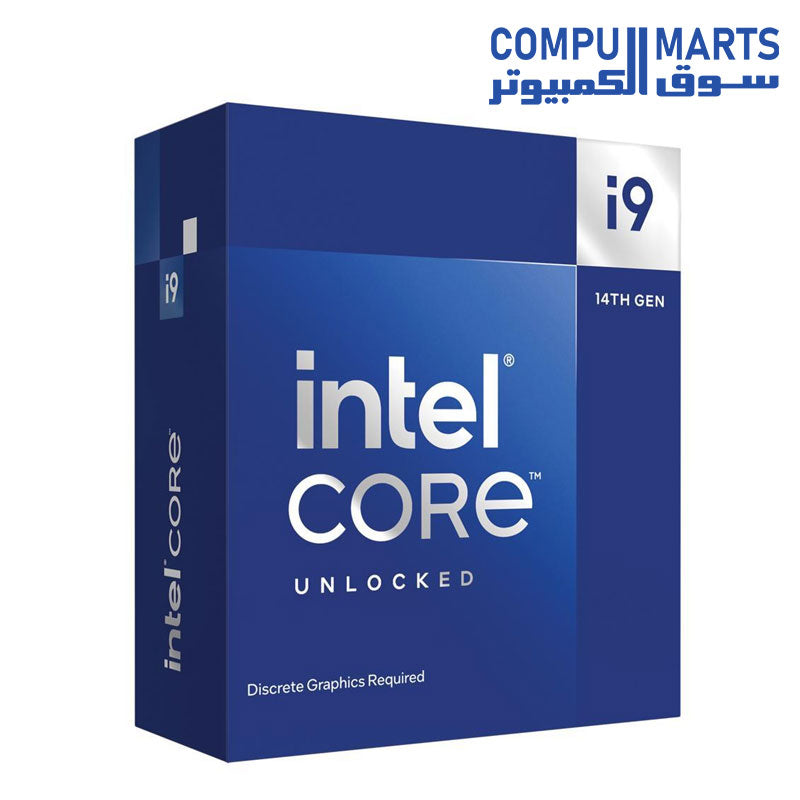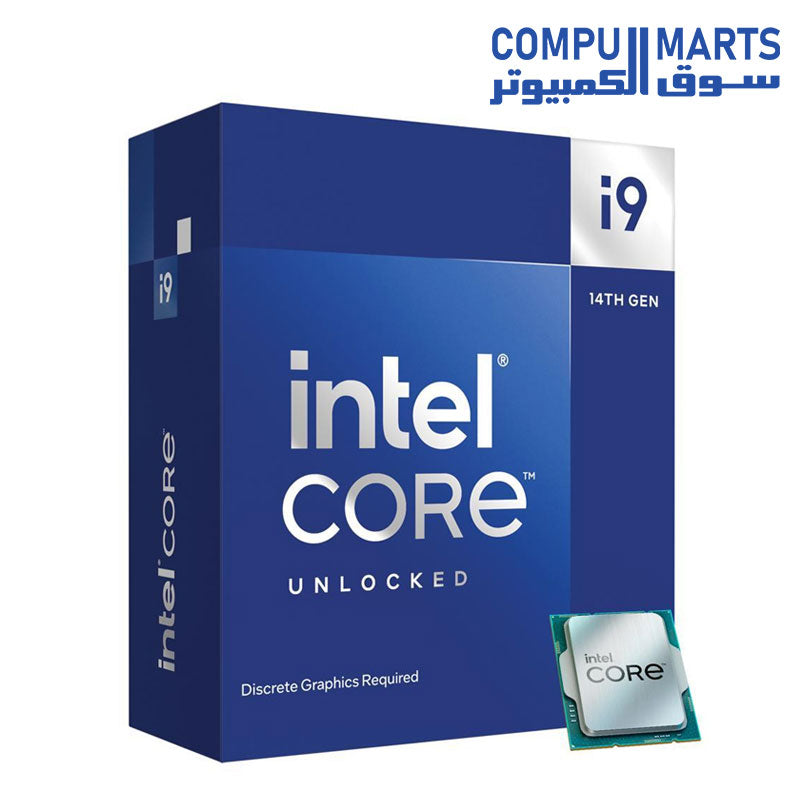Intel Core Desktop Processors
The Intel Core desktop processors (14th gen) deliver the ultimate immersive experience for gaming and creating.
This new generation of processors continue to utilize Intel’s performance hybrid architecture1 to optimize your gaming, content creation, and productivity. Take advantage of platform innovation designed for delivering flexibility and supercharge your CPU performance with a powerful suite of tuning and overclocking tools. Support for the Intel 700 series chipsets and backwards compatibility with the Intel 600 series chipsets allow you to access the features you need for any task. Whether you are working, streaming, gaming, or creating, Intel Core desktop processors deliver the ultimate immersive experience.

Extended Core Technology
Intel® Core desktop processors feature enhancements and technologies designed to enable the experiences you are looking for. These processors feature performance hybrid architecture1, combining two core microarchitectures on a single processor die. This architecture features Performance-cores, Efficient-cores and Intel Thread Director2. With up to 24 cores (8 Performance-cores and 16 Efficient-cores) and up to 32 threads. The Intel Core i9 processor P-cores are capable of reaching 6.0 Ghz with Intel Thermal Velocity Boost3, 4 to elevate performance. The Intel Core i7 processor Efficient-cores have been increased, with now up to 20 cores (8 P-cores + 12 E-cores) and 28 threads to handle demanding multitasking workloads. Intel Core desktop processors include a suite of advanced tools and technologies, Intel Dynamic Tuning Technology, Intel Turbo Boost Max 3.0 Technology3, Intel Thermal Velocity Boost3, 4, Intel Adaptive Boost3, 4, and more.

Immersive Experiences
Whether you're interested in overclocking, graphics technologies, or connectivity features, Intel Core desktop processors deliver the features to enable immersive experiences. Featuring overclocking tools for both experts and new users; Intel Extreme Tuning Utility5, Intel Extreme Memory Profile5, and Intel Dynamic Memory Boost5, 6—help deliver intelligent overclocking performance to get more from unlocked processors. Intel graphics technologies are more than just integrated graphics—they enable next-gen immersive experiences. With Intel Ultra-High-Definition Graphics featuring Xe architecture7. Supporting up to for concurrent DDI ports, and up to 8K HDR support and enhanced media support7. This new generation of processors supports discrete Intel Wi-Fi 7 (5 Gig). Wi-Fi 7 will expand upon the innovation of Wi-Fi 6 and Wi-Fi 6E to not only enable faster speeds, but dramatically improve responsiveness and reliability for future usages that demand extreme consistency and precision. Take advantage of Bluetooth LE Audio support for true wireless stereo, higher-fidelity sound, and new audio sharing capabilities.

Accelerating Platform Innovation
Designed for industry-leading technology while delivering platform flexibility. Compatibility with Intel 600 and 700 series chipset-based motherboards8 offers you the flexibility to upgrade without compromising on performance or features. Take advantage of DDR5 support with speeds up to 5600 MT/s, for high bandwidth, and enhanced productivity, as well as continued DDR4 support up to 3200 MT/s. With next-level I/O integration, this platform has up to 16 PCIe 5.0 lanes9 for a high-speed GPU, SSD or other add-in cards. It also offers up to 20 PCIe 4.0 lanes and up to 8 DMI 4.0 lanes for fast communication for components. Discrete Thunderbolt 4 technology supports connected accessories with up to 40 Gbps bandwidth.
Features at a Glance
Feature
|
Benefit
|
Performance-core (P-core)
|
The highest-performing CPU core ever built by Intel, designed to handle single-threaded, lightly threaded, or burst workloads like 4K gaming and 3D design.
|
Efficient-core (E-core)
|
Designed to handle multi-threaded and background tasks such as minimized browser tabs, IT services, and cloud syncing, leaving P-cores free to deliver incredible performance without interruption.
|
Performance Hybrid Architecture1
|
Integrates two core microarchitectures into a single die, prioritizing and distributing workloads to optimize performance.
|
Intel Thread Director2
|
Optimizes workloads by helping the OS scheduler intelligently distribute workloads to the optimal cores.
|
PCIe 5.02 up to 16 Lanes
|
Offers readiness for up to 32 GT/s for fast access to discrete graphics, storage, and peripheral devices with up to 16 PCI Express 5.0 lanes.
|
PCIe 4.0 up to 4 Lanes
|
Offers up to 16 GT/s for fast access to storage and peripheral devices with up to 4 PCI Express 4.0 lanes.
|
Up to DDR5 5600 MT/s10
|
Delivers the latest, industry-leading innovation in memory capabilities for fast speeds, high bandwidth, and enhanced workflow productivity.
|
Up to DDR4 3200 MT/s
|
Continued support of existing memory technology and speeds.
|
L3 and L2 Cache
|
Increased shared Intel Smart Cache (L3) and L2 cache sizes allow users to work faster, with larger datasets.
|
Intel Deep Learning Boost
|
Accelerates AI inference to improve performance for deep learning workloads.
|
Gaussian & Neural Accelerator 3.0 (GNA 3.0)
|
Processes AI speech and audio applications such as neural noise cancellation while simultaneously freeing up CPU resources for overall system performance and responsiveness.
|
Intel Adaptive Boost Technology3, 4
|
Intel ABT improves performance by opportunistically allowing higher multi-core turbo frequencies, while operating within system power and temperature specifications when current, power, and thermal headroom exists.
|
Intel Thermal Velocity Boost3, 4
|
Intel Thermal Velocity Boost opportunistically and automatically increases clock frequency of select 13th Gen Intel Core desktop processors by up to 100 MHz if the processor is at a temperature of 70°C or lower and turbo power budget is available.
|
Intel Turbo Boost Max Technology 3.0
|
Identifies the processor’s fastest cores and directs critical workloads to them.
|
Intel UHD Graphics driven by Xe Architecture7
|
Rich media and intelligent graphics capabilities enable amplified visual complexity, enhanced 3D performance, and faster image processing.
|
Overclocking5 Features and Capabilities
|
When paired with the Intel Z790 or Z690 chipset, processor P-cores, E-cores, graphics, and memory can be set to run at frequencies above the processor specification resulting in higher performance.
|
Intel Extreme Tuning Utility5
|
A precision toolset for tuning and overclocking, featuring memory and hybrid processor overclocking, so that new and experienced users can get more from their unlocked processors.56
|
Intel Extreme Memory Profile 3.0
|
Simplifies the memory overclocking experience with increased flexibility, additional profiles, and expanded voltage controls.
|
Intel Dynamic Memory Boost2, 6
|
Intelligent memory overclocking performance on-demand that optimizes platform performance based on usage.
|
Intel Core i9K and i9KF
|
|
|
|
Max Turbo Frequency [GHz]
|
Up to 6.0
|
|
|
Intel Turbo Boost Max Technology 3.0 Frequency [GHz]
|
Up to 5.8
|
|
|
Performance-core Max Turbo Frequency [GHz]
|
Up to 5.6
|
|
|
Efficient-core Max Turbo Frequency [GHz]
|
Up to 4.4
|
|
|
Processor Cores (P-cores + E-cores)
|
24 (8P + 16E)
|
|
|
Intel Hyper-Threading Technology
|
Yes
|
|
|
Total Processor Threads
|
32
|
|
|
Intel Thread Director
|
|
|
|
Intel Smart Cache (L3) Size [MB]
|
36 MB
|
|
|
Total L2 Cache Size [MB]
|
32 MB
|
|
|
Max Memory Speed [MT/s]
|
DDR5-5600
DDR4-3200
|
Number of Memory Channels
|
2
|
CPU PCIe 5.0 Lanes
|
Up to 16
|
CPU PCIe 4.0 Lanes
|
4
|
Enhanced Intel UHD Graphics driven by Xe Architecture
|
i9K: Intel UHD Graphics 770
i9KF: No
|
|
|
Graphics Dynamic Frequency [MHz]
|
1650
|
|
|
Processor P-core / E-core / Graphics / Memory Overclocking
|
Yes
|
Intel Quick Sync Video
|
Yes
|
Intel Deep Learning Boost (Intel DL Boost)
|
Yes
|
Intel Advanced Vector Extensions 2 (Intel AVX2)
|
Yes
|
Intel Gaussian and Neural Accelerator (GNA)
|
Yes
|
Notes:
1. Performance hybrid architecture combines two core microarchitectures, Performance-cores (P-cores) and Efficient-cores (E-cores), on a single processor die first introduced on 12th Gen Intel Core processors. Select 12th Gen and newer Intel Core processors do not have performance hybrid architecture, only P-cores or E-cores, and may have the same cache size. See ark.intel.com for SKU details, including cache size and core frequency.
2. Built into the hardware, Intel Thread Director is provided only in performance hybrid architecture configurations of 12th Gen or newer Intel Core processors; OS enablement is required. Available features and functionality vary by OS.
3. Intel Hyper-Threading Technology, Intel Turbo Boost Max Technology 3.0, and Intel Thermal Velocity Boost are only available on Performance-cores.
4. Intel Core i9 desktop processors (14th gen) only.
5. Unlocked features are present with select chipsets and processor combinations. Altering clock frequency or voltage may void any product warranties and reduce stability, security, performance, and life of the processor and other components. Check with system and component manufacturers for details.
6. Intel Dynamic Memory Boost enablement capability requires BIOS selection of the feature, a compatible Intel Core desktop processor, a compatible motherboard with BIOS support for the feature, and XMP certified DDR4 or DDR5 main system memory.
7. Available only on Intel Core processors (14th gen) featuring integrated graphics.
8. Check motherboard vendor for compatible BIOS.
9. CPU PCIe lanes are only validated for discrete graphics (x16) and PCIe storage.
10. On select processor SKUs. DDR5-5600 MT/s 1DPC UDIMM 1Rx8, 1Rx16 (lead supplier) and DDR5-5200 1Rx8, 1Rx16, 2Rx8 are POR on all Intel Core i9 desktop processor SKUs, all Intel Core i7 desktop processor SKUs, and select Intel Core™ i5 desktop processor SKUs (14th gen).











